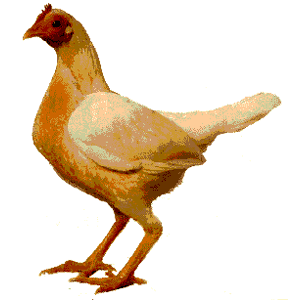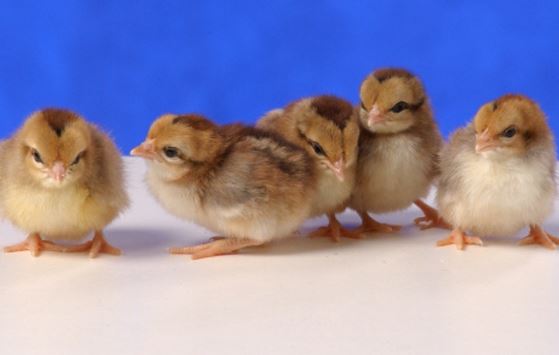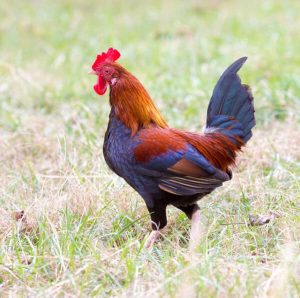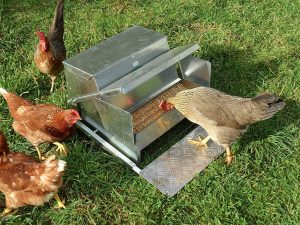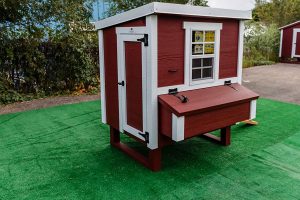Breed History
This amazing breed has some of the longest recorded history of any breed of chicken. As the name suggests it is an English breed but it was first introduced to the British shores by Romans in the 1st century.
The bird showed all the attributes needed to be a good fighter and cock fighting was extremely popular in Britain, as it was an affordable sport for all ‘walks of life’. It was also a sport in which people could gamble on the outcome of the fight and fights often drew large crowds.
Cock fighting was so popular infact, it was even introduced into public schools in Britain, as a way to encourage students to develop the same characteristics that old English game possessed. Strength, endurance and a fighting attitude.
Then in Victorian Britain in 1849 cock fighting was banned, now normally this would mean the breed would lose it popularity and numbers could have dwindled or even meant the breed became non-existent. But fortunately it coincided with an increase in popularity for ‘showing’ birds and the old English game with it unique attributes from centuries of fighting was incredibility popular once again.
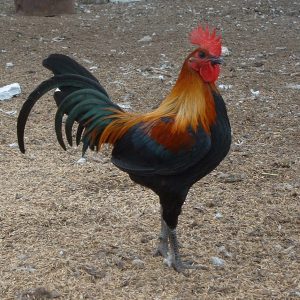
The Old English Game chickens were descendants of ancient fighting cocks and have changed little in profile or appearance in nearly a 1000 years. Present day Old English Game Fowl are still kept all over the world, as the revival of heritage breeds seems to push this breed to new highs.
Old English Game Weight
A cock weighs 5lb (2.25kg) and hens weigh 4lb (1.8kg)
Eggs
Size
Small
Color
Tinted Light Brown to White
Production per year
40-160 depending on the strain.
When do they start laying eggs?
Around 24 weeks as chicks mature slowly
Old English Game Characteristics
Temperament – do they make good as pets?
Old English Game birds have changed slightly from their fighting days, but their fighting spirit can still remain. Young chicks have even been known to fight each other! Both males and females are hardy but can be noisy. They fly very well, and don’t tolerate confinement, so free range is the best backyard setting for this breed.
They have been known to roost in trees, which we think is a throwback to when they were wild in Britain. Flying up to branches in trees to sleep and avoid predators on the ground.
They are fairly independent like most breeds that are good foragers, they can, if free range, source a lot of their own food. They are then the one breed in your flock that you can just ‘leave to it’. They have such unique features that they are always admired as backyard pets.
The males will keep the rest of the flock safe and stop any bullying occurring immediately. The males in that sense are excellent to have within a flock. Two males however doesn’t tend to work well, with them fighting as they try to out compete each other to ‘show off’ to the ladies about who is more ‘macho’. If two males fight they will need to be separated.
For a game bird the hens lay well, and actually make excellent mothers. They will raise offspring that aren’t their own too, making them awesome foster mothers, keeping the chicks very safe.
The males can occasionally do something unseen elsewhere in chicken breeds, they can assist in the rearing of chicks and adopt the brood. Special indeed!
How do I tame Old English Game chickens?
Start by feeding them some treats and slowly encouraging them over to you. Begin throwing the treats when they approach you so they know what it is, then gradually they will build up to eating from your hand.
The best way is to handle them as chicks. Building a bond early on will develop as they grow older. Handling chicks 3-4 times a day will get them used to human interaction and mean they will be very tame as adults.
How many do I need to buy?
Its only recommended to have one male within a flock. There is no limit on the amount of amazing hens you can have however. The best ratio for English Game is 10:1. Meaning 10 hens for every 1 cockerel.
You may not need to buy many as they live to be around 15 years old, often outliving the rest of the flock. So they are a chicken that will bring you pleasure for years to come.
How much space do they need?
Old English game are quite a small bird which often surprises people when they heard of its fighting attributes. They still need a minimum of 3-4sqft per bird of coop space but much more outside space.
Free range is best, so they are a prefect breed if you have a fair amount of space. With little space they will be unhappy and tend to be loud and even more noisy.
A way to tell if you haven’t given an old English game bird enough space is they will pace up and down the fence line looking for a way out. They also won’t be foraging or scratching around as much and egg production in the females will be lower than normal. Lots of space is therefore recommend for this breed to keep them healthy and happy.
Will they mix with my other chickens?
The females will mix well into flocks, if you have particularly alert birds already within your flock, breeds like Rhode Islands or Welsummers there could be some ‘stand-off’ situations as the new pecking order is established. For this reason don’t introduce less than 2 females to an existing flock.
As previously discussed males can fight each other, so just one old English male is recommended in any flock.
Appearance
Old English game chickens have a unique appearance mainly from their previous ring fighting days. Similar to a boxer they have developed specific muscles and a body to go with it. They can look similar to a Modern Game which is a breed that was developed from the fighting old English game, at the time cock fighting was banned. It was bred with other breeds but just for the purposes of ‘showing’.
Old English are fairly small birds with tightly feathered plumage. This was excellent as it kept it from being pulled whilst fighting but it now serves only to keep them warm in cold winters!
Their bodies are very muscular with broad shoulders from the jumping and wing flapping that used to occur during the fighting, often most of the ‘clashes’ took place off the ground, in the air.
There are infact two different types of Old English Game Fowl. A Carlisle and an Oxford. Both named after the cities in England in which the breed clubs where formed.
Carlisle is in the north of England whilst Oxford is in the south. After the banning of cock fighting in England people began to alter the breed for showing, this is why the two clubs set up as they couldn’t agree on what the bird should look like.
Carlisle Old English Game
The Carlisle birds are have a horizontal/flat back and are broader. They are also larger and so are heavier with males weighing up 2.95kg (6.5lb) and the females weighing 2.5kg (5.51lb). There are 13 different varieties of Carlisle Old English Game.
Oxford Old English Game
The Oxford Old English Game are more similar to the original game fighting fowl. They are more slender with a back at 45° to the ground. This makes them look slightly more stood upright than the Carlisle.
There are 30 varieties of the Oxford making them one of the most diverse breeds. Being sometimes up to 50% lighter in comparison, the males weigh 1.8-2.5kg (3.9lbs-5.5lb) the females weigh 0.9-1.36kg or 1.98-3lb.
Both breeds types have a small single comb, and have wattles that are small too. Their head is also small but they have a strong large beak and strong wings with short but powerful legs.
Feeding
What should I feed them?
As chicks they require chick crumb or starter chick, it’s the same feed, manufacturers just call it differently. They will eat this up to 6 weeks old.
At six weeks old they will need to be moved onto growers mash this contains all the right nutrients they require to get them to near maturity.
At around 18 weeks, Old English’s need to be fed layers pellets. This contains everything they need to help the hens lay their first eggs. I usually give them the feed slightly earlier as then they have time to fully absorb the goodness from the feed. After all producing their first egg is a big deal. They will then be fed layers pellets till they stop laying or for the rest of their lives.
Up to laying their first egg I always have feed available in the feeder. It also goes without saying that they require fresh water to be available at all times. I have feed available in the feeder as they don’t yet have set meal times being chicks. They eat and sleep whenever they want to, meaning they could feed during the night, so there needs to be food available so you don’t stunt their growth at this critical time.
From maturity i.e laying their first egg, you can if you want, portion the feed out on a daily basis. Or just leave a feeder full and let them eat what they require.
How much should I feed them?
They will typically eat between 80-120g per day per bird (2.8-4.2oz). If allowed to forage whilst free range they can supplement lots of that feed with fresh grubs, worms and insect’s etc. This will save you some money on the feed bill!
They eat less in the hotter summer months due to the heat, so I actually supplement their feed with high water content fruits like watermelon and cucumber so that they are eating something firstly. But secondly, getting important fluids into them, as chickens can suffer from dehydration and heat stress quite quickly.
The Old English are slightly more hardy than most so you have less to worry about though.
What can’t they eat?
Old English game fowl can’t eat chocolate or beans. Dried beans actually being worse than non-dried. This could slip into their diet by feeding them scraps from the table, which is actually illegal in the UK, so be really vigilant. Both chocolate and beans cause chickens to cardiac arrest.
Be extra vigilant also that they can’t come across beans plants if your growing vegetables at home. Old English game fowl love to forage and free range so be careful…
What do I need to keep Old English Game?
Feeder & Waterer
You need a feeder and waterer for every 6 chickens in your flock. The avoids squabbles and fights. It’s especially true when introducing old English game fowl to your flock as certain birds can get aggressive over food with ‘new comers’. Male old English cocks will often match that sentiment, causing friction and fights. You really want to avoid this so make sure you have enough feeders and waterers.
I’d go with a galvanized one over a plastic waterer, ours is metal and has lasted for years and years, whereas the plastic ones when they are left outside just split and crack. Metal ones are also easier to sanitize as I only use boiling water for this, I don’t use any chemicals. You can’t risk leaving even trace amounts of cleaning detergents in the waterer. Doing this with plastic waterers would, again, just crack and split them.
The style I would recommend is a grandpa style feeder. Its incredibly well built and as such lasts a really long time. It will basically cut your feed bill by about half, seriously! It reduces waste and that’s great but that also that means less vermin.
Rats are unwelcome pests around chicken coops, they carry disease’s and are a carrier of the mites that cause scaly leg mite in chickens. It can be a horrible infection for chickens and so its always best to take preventative measures to avoid it. Now you can – grandpa feeders – perfect.
The Coop
Old English fowl like to roost high up. The higher the better, normally 3+ feet. So you need a coop that can provide this. Floor space requirements are 3-4ft coop space per bird as a minimum also. So a coop for 6 chickens, for example, would need to be 18-24sqft.
The coop for me, that will last well, is the OverEz its really well made and sold on Amazon. It’s a really good design, but what I particularly like is all the doors will lock in the open and closed position. There is also a silver reflective material on the inside of the roof. That helps to cool the coop in hot summers, which we have, by reflecting the heat from the sun back out through the roof. It also has good ventilation, crucial in both summer and winter to remove moisture build up from chicken poop.
If you really can’t totally free range them, one option could be purchasing a large Giantex run. They come in different sizes to suit your exact needs, they are simple to put together and are light enough to move even daily with two people lifting either end.
You can fix it, using the holes, to the ground for extra security and its easy enough to do what we have done, which is have an electric fence round the outside. Its great if you want to semi free range them but safely enough so you haven’t got to worry.
Breed Recap
Old English game chickens are a fantastically diverse breed with over 40 varieties, that have a rich long history and would suit any free range backyard flock.
The hens lay well for game birds and make superb mothers and foster mothers for other breeds of chicks and the males make excellent cockerels to keep order within the flock. Perfect then if you have chickens with ‘large characters’, or plan too have.
Old English Game Chickens for Sale
In the US there only a few good hatcheries that have a good selection of chicks. Cackle Hatchery is one of them. They ship out to all states and have excellent reviews, go check for yourself. Plus being a 3rd generation family business they also have a wealth of knowledge and that makes choosing really easy.
Old English Game chicks can be found here on their website www.cacklehatchery.com
